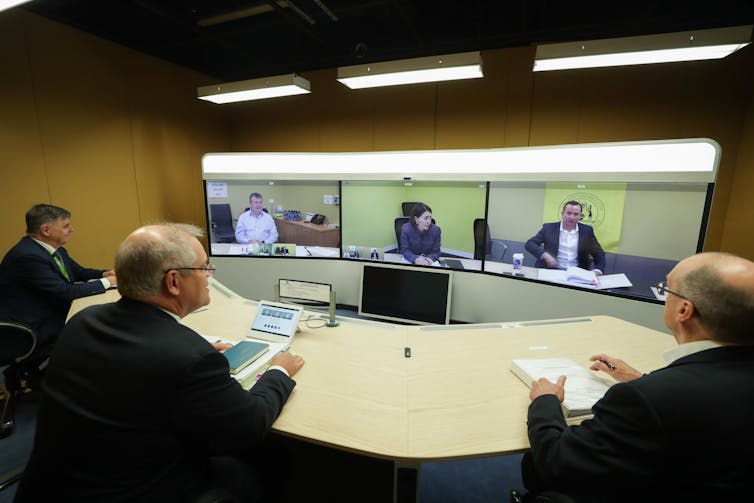Australian political leaders are good crisis managers. The establishment of the National Cabinet in March 2020, which brought together the prime minister, state premiers and territory chief ministers to coordinate the national response to the COVID pandemic, played into this strength.
Compared to other intergovernmental forums, the National Cabinet was designed to be nimble, decisive and not weighed down by bureaucracy.
However, three years on, and with the pressing nature of the pandemic easing, it’s time to rethink the National Cabinet. With the leaders gathering today in Canberra, a central question looming over the meeting is whether the group is still fit for purpose.
Late last year, Griffith University’s Policy Innovation Hub convened a workshop bringing together experts, politicians and other stakeholders to review National Cabinet’s performance and identify how it can be improved in the future. We reached three main points of agreement.
1. An informal approach is no longer sustainable
While the current model for National Cabinet worked well at the height of the pandemic, the same approach is not ideal today.
Since the abolition of the Council of Australian Governments (COAG) in 2020, National Cabinet has served as the primary forum for Australia’s leaders to meet and consider important issues facing the country.
But National Cabinet’s emphasis on informality, which came to be valued by political leaders during the pandemic, is not a sound basis on which to deal with the complex challenges facing the nation.
While avoiding the mire of bureaucracy might often be a good thing, we also need to develop a set of principles or touchstones to guide and monitor the success of the National Cabinet. We also need greater selectivity and justification of the projects the cabinet focuses on, and a reasonable balance between stability, flexibility and priorities.

2. The veil of secrecy must be lifted
The National Cabinet is still shrouded in secrecy. From the outset, then-Prime Minister Scott Morrison argued it was protected by cabinet confidentiality, which prevented public disclosure of discussions and documents considered by the body.
This argument was rejected by the Administrative Appeals Tribunal in 2021. Federal Court Justice Richard White held that simply naming the institution a “cabinet” did not automatically grant it confidentiality.
Read more: Morrison government loses fight for national cabinet secrecy
But even after that decision, both the Morrison and Albanese governments have refused Freedom of Information requests for National Cabinet documents.
As a federation, Australia already struggles with accountability, as it can be easy for governments to shift blame to one another. For example, the federal and Victorian governments argued over who was to blame for COVID outbreaks in aged care centres in 2020.
Adding in a policy of blanket secrecy about National Cabinet further constrains our ability to hold governments accountable and undermines public trust.
To be sure, there is some value in preserving the privacy of National Cabinet discussions. In a regular cabinet, for example, it allows members to have rigorous debate and consider all options before coming to a unified position.
The key, then, is to strike a balance between encouraging frank discussions between our leaders and promoting transparency. A good starting point would be to return to the partial Freedom of Information exemption that operated under COAG. This allowed for documents to be released under a Freedom of Information request – with the agreement of all jurisdictions – while preserving the confidentiality of the details of the leaders’ discussions.
Read more: Nowhere to hide: the significance of national cabinet not being a cabinet
3. National Cabinet must have a true federal-state balance
Australia is at its best when it operates as a true federation, with state governments given space to innovate, learn from one another and collaborate.
The response to the pandemic is a good example: as infection patterns varied around the country, each state was able to respond to local conditions as needed. If the National Cabinet is to succeed into the future, its participants must be committed to the aims of federalism.
Any reform of National Cabinet should ensure it is a truly federal body. An intergovernmental agreement could formalise the National Cabinet’s governance arrangements and clarify its role and function. It could also add innovations, such as a a joint Commonwealth-state secretariat.
The National Cabinet, like COAG before it, is currently a top-heavy body.
The topics the Commonwealth government deems important tend to be prioritised and the states have limited opportunities to raise issues they see as important. In addition, the Commonwealth has a bias towards uniform policies rather allowing variation to suit local needs. The Commonwealth also has a larger revenue base, giving it a stronger bargaining position compared to the states.
These issues remain a challenge to fostering greater equality in the National Cabinet and optimising our federation to the greatest advantage.
Read more: Will national cabinet change federal-state dynamics?
Where to from here?
The National Cabinet played a vital role in seeing Australia through the worst of the pandemic. But the transition from COAG to the National Cabinet was so swift, there was no opportunity to develop a truly workable, sustainable model. We need a body suited to meet the substantial challenges the nation faces into the future.
Australians have a well-honed scepticism of bureaucratic talk fests, but there is also frustration at the perceived inability of government to undertake long-term reform. The National Cabinet has an opportunity to learn from the deficits of COAG and create a lasting model of federal cooperation and achievement.

